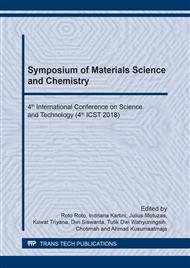[1]
M.A. Green, A. Ho-Baillie, Perovskite solar cells: The birth of a new era in photovoltaics, ACS Energy Lett. 2 (2017) 822–830.
DOI: 10.1021/acsenergylett.7b00137
Google Scholar
[2]
F.D. Angelis, D. Meggiolaro, E. Mosconi, A. Petrozza, M.K. Nazeeruddin, H.J. Snaith, Trends in perovskite solar cells and optoelectronics: Status of research and applications from the psco conference, ACS Energy Lett. 2 (2017) 857–861.
DOI: 10.1021/acsenergylett.7b00217
Google Scholar
[3]
A. Kojima, K. Teshima, Y. Shirai, T. Miyasaka, Organometal halide perovskites as visible-light sensitizers for photovoltaic cells, J. Am. Chem. Soc. 131 (2009) 6050–6051.
DOI: 10.1021/ja809598r
Google Scholar
[4]
W.S. Yang, B.-W. Park, E.H. Jung, N.J. Jeon, Iodide management in formamidinium-lead-halide – based perovskite layers for efficient solar cells, Science 356 (2017) 1376–1379.
DOI: 10.1126/science.aan2301
Google Scholar
[5]
J. Gong, S.B. Darling, F. You, Perovskite photovoltaics: Life-cycle assessment of energy and environmental impacts, Energy Environ. Sci. 8 (2015) 1953–(1968).
DOI: 10.1039/c5ee00615e
Google Scholar
[6]
T. Wu, J. Wu, Y. Tu, X. He, Z. Lan, M. Huang, J. Lin, Solvent engineering for high-quality perovskite solar cell with an efficiency approaching 20%, J. Power Sources 365 (2017) 1–6.
DOI: 10.1016/j.jpowsour.2017.08.074
Google Scholar
[7]
F.K. Aldibaja, L. Badia, E. Mas-Marzá, R.S. Sánchez, E.M. Barea, I. Mora-Sero, Effect of different lead precursors on perovskite solar cell performance and stability, J. Mater. Chem. A (3) (2015) 9194–9200.
DOI: 10.1039/c4ta06198e
Google Scholar
[8]
N.-G. Park, Methodologies for high efficiency perovskite solar cells, Nano Converg. 3 (2016) 15.
Google Scholar
[9]
T. Li, Y. Pan, Z. Wang, Y. Xia, Y. Chen, W. Huang, Additive engineering for highly efficient organic – inorganic halide perovskite solar cells : recent advances and perspectives, J. Mater. Chem. A Mater. energy Sustain., 00 (2017) 1–51.
DOI: 10.1039/c7ta01798g
Google Scholar
[10]
P.W. Liang, C.Y. Liao, C.C. Chueh, F. Zuo, S.T. Williams, X.K. Xin, J. Lin, A.K.Y. Jen, Additive enhanced crystallization of solution-processed perovskite for highly efficient planar-heterojunction solar cells, Adv. Mater. 26 (2014) 3748–3754.
DOI: 10.1002/adma.201400231
Google Scholar
[11]
H.J. Yen, P.W. Liang, C.C. Chueh, Z. Yang, A.K.Y. Jen, H.L. Wang, Large grained perovskite solar cells derived from single-crystal perovskite powders with enhanced ambient stability, ACS Appl. Mater. Interfaces 8 (2016) 14513–14520.
DOI: 10.1021/acsami.6b02169
Google Scholar
[12]
H. Tsai, W. Nie, Y.H. Lin, J.C. Blancon, S. Tretiak, J. Even, G. Gupta, P.M. Ajayan, A.D. Mohite, Effect of precursor solution aging on the crystallinity and photovoltaic performance of perovskite solar cells, Adv. Energy Mater. 7 (2017) 1–9.
DOI: 10.1002/aenm.201602159
Google Scholar
[13]
H. Rong, Yaoguang. Hou, Xiaomeng. Hu, Yue. Mei, Anyi. Liu, Linfeng. Wang, Ping. Han, Synergy of ammonium chloride and moisture on perovskite crystallization for efficient printable mesoscopic solar cells, Nat. Commun. 8 (2017) 1–8.
DOI: 10.1038/ncomms14555
Google Scholar
[14]
S. Lou, T. Xuan, C. Yu, M. Cao, C. Xia, J. Wang, H. Li, Nanocomposite of CsPbBr3 perovskite nanocrystals in an ammonium bromide frame with enhanced stability, J. Mater. Chem. C 5 (2017) 7431-7435.
DOI: 10.1039/c7tc01174a
Google Scholar
[15]
J.H. Noh, S.H. Im, J.H. Heo, T.N. Mandal, S.Il Seok, Chemical management for colorful, efficient, and stable inorganic-organic hybrid nanostructured solar cells, Nano Lett. 13 (2013) 1764–1769.
DOI: 10.1021/nl400349b
Google Scholar
[16]
L. Zhao, D. Luo, J. Wu, Q. Hu, W. Zhang, K. Chen, T. Liu, Y. Liu, Y. Zhang, F. Liu, T.P. Russell, H.J. Snaith, R. Zhu, Q. Gong, High-performance inverted planar heterojunction perovskite solar cells based on lead acetate precursor with effi ciency exceeding 18%, Adv. Funct. Mater. 26 (2016) 3508–3514.
DOI: 10.1002/adfm.201601175
Google Scholar
[17]
D.V. Shinde, L. Pyeon, M. Pei, G.-W. Kim, H. Yang, T. Park, Enhanced efficiency and stability of an aqueous lead-nitrate-based organometallic perovskite solar cell, ACS Appl. Mater. Interfaces 9 (2017) 14023–14030.
DOI: 10.1021/acsami.7b01864
Google Scholar
[18]
N.J. Jeon, J.H. Noh, Y.C. Kim, W.S. Yang, S. Ryu, S.Il Seok, Solvent engineering for high-performance inorganic–organic hybrid perovskite solar cells, Nat. Mater. 13 (2014) 897–903.
DOI: 10.1038/nmat4014
Google Scholar
[19]
N. Ahn, D.Y. Son, I.H. Jang, S.M. Kang, M. Choi, N.G. Park, Highly reproducible perovskite solar cells with average efficiency of 18.3% and best efficiency of 19.7% fabricated via lewis base adduct of lead(II) iodide, J. Am. Chem. Soc. 137 (2015) 8696–8699.
DOI: 10.1021/jacs.5b04930
Google Scholar


